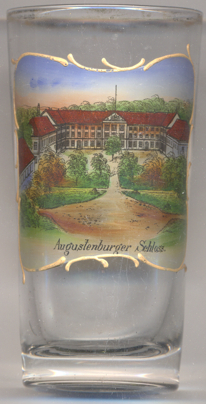

|
| DANMARK | DENMARK |
| Region Syddanmark | Region South Denmark |
Augustenborg (German: Augustenburg) is located on Als Island the Augustenborg Fjord about 8 km northeast of Sønderborg and about 18 km southeast of Nordborg. Augustenborg has a population of about 3,300 (2016) and since 2006 is part of the Sønderborg Kommune.
 The town originated around Augustenburg Palace which was built by Duke Ernst Günther, first duke of
Schleswig-Holstein-Sonderburg-Augustenburg in the years after 1651. The palace, and the town
consequently, received the name in honor of Ernest's wife Auguste, Princess of Schleswig-Holstein-Sonderburg-Glücksburg.
The palace became the chief seat of their line which used the name Augustenborg as its branch name. Later, a Danish
king made the head of that line specifically Duke of Augustenborg. Since 1764, the branch of Schleswig-Holsten-Sonderborg-Augustenburg
was genealogically the next senior branch immediately after the main line of Danish kings.
They grew in relative prominence in late 18th century, and in the 19th century Schleswig-Holstein Question, being the
symbols of pro-German nationalistic movement in Schleswig-Holstein. The area was annexed by Prussia in 1864 from Denmark,
but the northern parts of Schleswieg were returned in 1920 following a plebiscite. The Augustenborg male line died out
in 1931. Their female-line descendant today holds the throne of Sweden.
The town originated around Augustenburg Palace which was built by Duke Ernst Günther, first duke of
Schleswig-Holstein-Sonderburg-Augustenburg in the years after 1651. The palace, and the town
consequently, received the name in honor of Ernest's wife Auguste, Princess of Schleswig-Holstein-Sonderburg-Glücksburg.
The palace became the chief seat of their line which used the name Augustenborg as its branch name. Later, a Danish
king made the head of that line specifically Duke of Augustenborg. Since 1764, the branch of Schleswig-Holsten-Sonderborg-Augustenburg
was genealogically the next senior branch immediately after the main line of Danish kings.
They grew in relative prominence in late 18th century, and in the 19th century Schleswig-Holstein Question, being the
symbols of pro-German nationalistic movement in Schleswig-Holstein. The area was annexed by Prussia in 1864 from Denmark,
but the northern parts of Schleswieg were returned in 1920 following a plebiscite. The Augustenborg male line died out
in 1931. Their female-line descendant today holds the throne of Sweden.
 Augustenborg Palace [left, no. 3210]
is situated in the southwestern part of Augustenborg, overlooking Augustenborg Fjord.
The original half-timbered manor house was built in 1660–1664 by Ernest Günther, the first Duke of Augustenborg,
after he bought the village of Stavensbøl and demolished it for the land. The one-storey, red-roofed buildings
around the outer courtyard were added from 1733 while the main three-winged building, replacing the original manor, was
built from 1770 to 1776 in full symmetry, a fine example of Baroque architecture. During the same period, much of the
town was regenerated. The palace building underwent further renovation in the 1920s.
Hans Christian Andersen spent two weeks at the palace in the autumn of 1844 and wrote The Little Match Girl when he
visited the castle. During the First Schleswig War (1848–50), Christian August II, the last duke to live in the
palace, left Augustenborg as a result of his close relations with Germany. Thereafter the building was first used as
a barracks and from 1878 as a seminary for women. In 1921, Augustenborg was purchased by the Danish state. It was fitted
out as a hospital in 1927–1928 and since 1932 has been used as a psychiatric hospital. There is an exhibit about
the palace, the town and its ducal history in the building's entryway.
Augustenborg Palace [left, no. 3210]
is situated in the southwestern part of Augustenborg, overlooking Augustenborg Fjord.
The original half-timbered manor house was built in 1660–1664 by Ernest Günther, the first Duke of Augustenborg,
after he bought the village of Stavensbøl and demolished it for the land. The one-storey, red-roofed buildings
around the outer courtyard were added from 1733 while the main three-winged building, replacing the original manor, was
built from 1770 to 1776 in full symmetry, a fine example of Baroque architecture. During the same period, much of the
town was regenerated. The palace building underwent further renovation in the 1920s.
Hans Christian Andersen spent two weeks at the palace in the autumn of 1844 and wrote The Little Match Girl when he
visited the castle. During the First Schleswig War (1848–50), Christian August II, the last duke to live in the
palace, left Augustenborg as a result of his close relations with Germany. Thereafter the building was first used as
a barracks and from 1878 as a seminary for women. In 1921, Augustenborg was purchased by the Danish state. It was fitted
out as a hospital in 1927–1928 and since 1932 has been used as a psychiatric hospital. There is an exhibit about
the palace, the town and its ducal history in the building's entryway.
[https://de.wikipedia.org/wiki/Augustenborg, https://en.wikipedia.org/wiki/Augustenborg;
https://en.wikipedia.org/wiki/House_of_Schleswig-Holstein-Sonderburg-Augustenburg;
https://en.wikipedia.org/wiki/Augustenborg_Palace]
![[scale]](lineal.jpg)